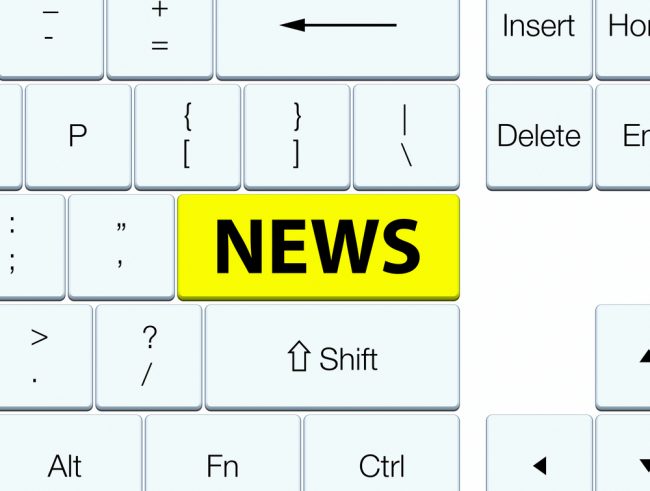 Keyboard with news button
Keyboard with news button
We're not perfect and sometimes we might get some things wrong. As I've said before, this truly is one of the friendliest industries I've ever worked in. And when we mess up, typically we get an email nudge from industry leaders and/or sources stating we got something wrong in a story.
Here's a typical example email I received last week: “Hi, Michael. When you can, please correct the title of
On the flip side, we have a growing list of stories that we just can't publish yet. Sometimes the information is too confusing and complex that the pieces just haven't come together yet to make a cohesive and valuable story for our readers. Other stories are honestly too salacious and/or could be downright career-ending for people in the industry. In these cases, it's not like these people have necessarily broken the law, they just made some bad decisions. And, you know what? Who are we to judge? We've all screwed up and we leave the judgement out of it.
When it comes to the sexier or, as some might refer to them, the TMZ-ish stories, as an editor of this publication, I'm not interested. Let me clarify. I'm not interested unless it meets a high enough standard to answer these questions: What will our credit union executive audience take away from this story? And from those takeaways, will our readers be informed, educated or entertained? From there, we break down the story further in order to make sure that we are doing our jobs correctly and accurately for this very specific news-gathering audience.
Often, we have stories that don't make it past the first question.
My point is, our team approaches the news and feature stories we create with a lot of thought. And even then, we sometimes get things wrong. And the things we get wrong, I appreciate and we all appreciate because it helps us be even more careful and thoughtful with our coverage and even our punctuation screw-ups. Personally, I like commas and em dashes – there's something really satisfying about an em dash.
My em dash infatuation aside, I wanted to use this week's column to let you know about a few things when it comes to getting your story noticed by us, as well as submitting Op-Eds for our website and print. Because all of these things are both wildly different strategies with some small caveats.
Pitching Us
It's an old, but very true statement that we get a lot of emails. You get a lot of emails each day I'm sure. In fact, personally, I think email has lost its usefulness to our communicative society due to the overload. True story: Last week I had 1,755 unread email. I filtered through them and found some from 2016. I came to terms with the fact that I'm obviously never going to respond to all of these and so I checked “mark all as read” just to get that stress off my brain. I'm sorry if I didn't respond two years ago or even two weeks ago. I just can't get to everyone.
Therefore, if you're reaching out to me for a story, give email a shot. And if you are emailing, please keep it short with two sentences stating the story idea. You don't have to write much and I won't have to download a PDF of your news release to see what you're emailing. Win-win!
A quick side note to the marketing and public relations professionals pitching us: Stop using the subject line to trick us with lines like “FWD: Compliance System Update for CUs” or “RE: Thought you might like this” We're on to you and we are deleting you.
If you really want to get my attention about a story, text me. Here's the thing with that directive: The story must answer “yes” to the question, “Does this have an impact on the credit union industry and/or is it unique?” Please be very selective with your pitches and do not spam my texts.
I wish we could get to all of the fun community news items you send to us. But, we have our limitations of time and resources. So, we must focus our attention on the bigger issues to help get the news out to our readers.
That doesn't mean that we don't get to the community news. We try to get some of those items on our social media feeds to share. So, thank you to those who send us information about fun events and photos.
Op-Ed Submissions
Natasha Chilingerian and I meet each Monday at 5 p.m. EST to go through all of the Op-Ed submissions we've received in the past week to read and discuss each one. It's true. We do this methodically and regularly. She is in charge of organizing and scheduling all of them as part of her duties with our print production. We typically map out Op-Eds two weeks to two months in advance for print. And if it doesn't make the cut for print or we just like it better for our website audience, it would run in the next few days depending on our content load. What do we like for print? Advice and topical reaction pieces do very well for our subscribers. Anything stating to “download our white paper” will not be used. Also, your submission must be exclusive to CU Times. The same goes for the shorter web Op-Eds.
When it comes to advice Op-Eds, we know there are so many smart, excellent and brainy people in our industry. And when you take the time to help others when it comes to topics like IT infrastructure or email marketing campaigns, our audience wants to hear from you. It's what makes this industry so connected. As far as the topical reaction Op-Eds, those are usually filled with so much passion and feeling about a topic, that it once again helps us all feel connected, like we're not alone in thinking that.
Our team runs CU Times and you help make it relevant. Thank you for that.
 Michael Ogden, CU Times Executive Editor
Michael Ogden, CU Times Executive EditorMichael Ogden is executive editor for CU Times. He can be reached at [email protected].
© 2025 ALM Global, LLC, All Rights Reserved. Request academic re-use from www.copyright.com. All other uses, submit a request to [email protected]. For more information visit Asset & Logo Licensing.






